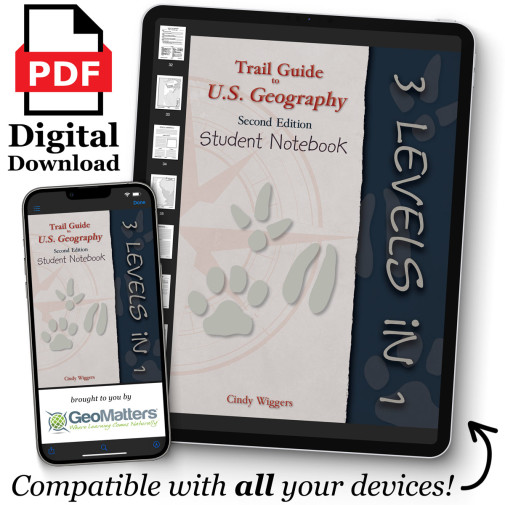We use cookies to make your experience better. To comply with the new e-Privacy directive, we need to ask for your consent to set the cookies. Learn more.
Trail Guide to U.S. Geography: Student Notebook All Levels - Digital Download
Includes a downloadable set of 500 formatted student notebooking pages for all three levels of Trail Guide to U.S. Geography, to help conveniently put together your student notebooks. These premade pages help both parents and students with guidance and structure in the building of their notebooks. These pages include questions, outline maps, lined paper, room for drawings, crosswords, and much more. These work alongside the Trail Guide to U.S. Geography book as answers to questions presented are only found in the textbook. PDF downloads are available on any device that has Acrobat Reader capabilities. ~Rebecca
This Trail Guide to U.S. Geography Student Notebook is a downloadable set of printable pre-formatted templates and outline maps for creating the awesome personal geography student notebooks recommended in the Trail Guide to U.S. Geography.
One of the most common questions we are asked at conventions and by phone regarding our Trail Guides is: "Where is the student book?" Our answer, "No workbook is needed because your students will create their own geography notebooks while they are learning," led to the next question, "How do we create a notebook?" Although you can build a geography student notebook using the information included in the Trail Guide to U.S. Geography, many folks prefer additional guidance. If you don't know how to create a student notebook, want more structure, or simply don't have time to figure it out for yourself, this is just what you need to catch the vision!
Over 500 pages include:
Geography Trails Questions: Separate pages with ALL THREE levels of daily geography trails questions and a place to put the answers.
Outline Maps: Specific outline maps required for each week and the list of mapping assignments.
Notebook Pages: A variety of specifically formatted templates associated with assignment choices for each week. Provides ample room to include written summaries, pictures, and drawings.
Generic Templates: A variety of templates students can use for creating their own crosswords, charts, fact sheets, reports, and more.
The Student Notebooks are available for each of the three trails in Trail Guide to U.S. Geography: Elementary (2nd-4th grades), Middle School (5th-7th grades), and High School (8th-12th grades).
Please note: You MUST have Trail Guide to U.S. Geography to make use of the Student Notebook. Answers to the daily Geography Trails questions, instructions for using the curriculum, and the Literature Unit are NOT included in the Student Notebook.
Following the same great format as Trail Guide to World Geography, this book focuses on U.S. Geography. The thirty-six weekly lessons in this book cover the fifty states, organized by region. Students study the states at a rate of about two per week. This easy-to-teach book covers essential geographical facts and features of each state. This trail guide includes 5-minute daily drills, mapping, building a geography notebook--using the optional student notebook--and a wide variety of additional projects with research and discovery. The literature unit in this book focuses on the Lewis and Clark expedition, using the book The Captain's Dog, by Roland Smith. Heavily used resources include Uncle Josh's Outline Map Book or maps available in the Student Notebook download. Other resources are also recommended to help enhance the study. In this edition, all students use the Desk Atlas of the United States. A Geographical Terms Chart is recommended with these and all Trail Guide studies. We do not offer the chart that is recommended; however, it is available through Geography Matters. This is the 2015 update. ~ Rachel S./Rebecca G.
| Product Format: | Other |
|---|---|
| Brand: | Geography Matters |
| Grades: | 2-12 |

